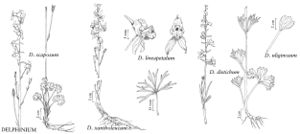Delphinium scaposum
Bot. Gaz. 6: 156. 1881, not D. scaposum W. T. Wang 1957.
Stems 25-50(-65) cm; base usually reddish, glabrous, glaucous. Leaves mostly basal, 4-10 at anthesis; cauline leaves 1-4 at anthesis; green leaves usually present on proximal 1/5 of stem at anthesis; petiole 1-12 cm, glabrous. Leaf blade ± round, 0.5-4 × 0.5-6 cm, puberulent to glabrous; ultimate lobes 3-9, width 2-15 mm (basal), 0.5-3 mm (cauline). Inflorescences 10-25(-40)-flowered, cylindric; pedicel ascending, 0.6-2.5 cm, glabrous; bracteoles 2-5 mm from flowers, green to blue, linear-lanceolate, 2-4 mm, glabrous. Flowers: sepals bright dark blue, glabrous, lateral sepals spreading, 11-14 × 4-6 mm, spurs straight, sometimes decurved, ascending 30-45° above horizontal, 13-18 mm; lower petal blades elevated, exposing stamens, 5-8 mm, cleft 2-4 mm; hairs mostly centered on inner lobes near junction of blade and claw, white. Fruits 12-16 mm, 2.5-3 times longer than wide, glabrous. Seeds: seed coat cells ± brick-shaped, cell margins straight, surfaces smooth. 2n = 16.
Phenology: Flowering spring.
Habitat: Juniper woods, grassland
Elevation: 1200-2700 m
Distribution

Ariz., Colo., N.Mex., Utah.
Discussion
Delphinium scaposum is reportedly used in Navajo and Hopi religous ceremonies, as well as for a wash following childbirth (D. E. Moerman 1986).
Selected References
None.
